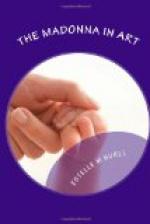Moretto’s ideals were an anticipation of the most advanced ideas of the modern science of physical culture. His Madonna and saints derive their beauty neither from over refinement on the one hand, nor from sensuous charms on the other, but from sane and harmonious self-development.
The Berlin Gallery contains a third glorified Madonna by the same painter, treated as a Holy Family. St. Elizabeth sits beside the Virgin, who holds her own boy on her right side, while bending to embrace the little St. John with the left arm. So large a group is not appropriately treated in this way, yet the picture is so fine a work of art as to disarm criticism.
Still another representative of the Brescian school must be considered in the person of Savoldo. Born of a noble family, and following painting as an amusement rather than as an actual profession, his works are rare, and one of the finest examples of his art is the Glorification of the Virgin, in the Brera Gallery, at Milan. The mandorla-shaped glory surrounds the Virgin’s figure, studded with faintly discerned cherub heads. On either side, a musical angel is in adoration; four saints stand on the earth below. The entire conception is rendered with the utmost delicacy: the grace and beauty of the Madonna are of exactly the quality to make her appearance a beatific vision.
From Brescia we turn to Verona, where we again find many pictures of the beautiful subject. There are, in the churches of Verona, at least three notable works, by Gianfrancesco Caroto, in this style. One is in Sant’ Anastasia, another is in San Giorgio, and the third—the artist’s best existing work—is in San Fermo Maggiore, and shows the Virgin’s mother, St. Anne, seated with her in the clouds.
Girolamo dai Libri was a few years younger than Caroto, and at one period was, to some extent, an imitator of the latter. Beginning as a miniaturist, he finally attained a high place among the Veronese artists of the first order. His characteristics can nowhere be seen to better advantage than in the Madonna of St. Andrew and St. Peter, in the Verona Gallery. The Virgin is in an oval glory, edged all around with small, fleecy clouds. She has a beautiful, matronly face, with abundant hair, smoothly brushed over her forehead. The two apostles, below, are fine, strong figures, full of virility.
Morando, or Cavazzola, was, doubtless, the most gifted of the older school of Verona, possessing some of the best qualities of the later master, Paolo Veronese. We should not leave the school, therefore, without mentioning a remarkable contribution he added to this class of pictures in his latest altar-piece. Here the upper air is filled with a sacred company, the Virgin and child are attended by St. Francis and St. Anthony, and surrounded by seven allegorical figures to represent the cardinal virtues. Below are six saints, specially honored in the Franciscan Order. The picture is called the finest production of the school in the first quarter of the sixteenth century.




